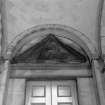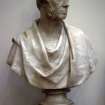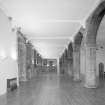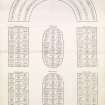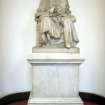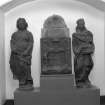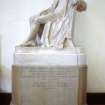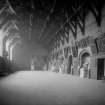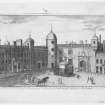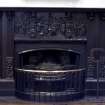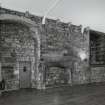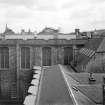Scheduled Maintenance
Please be advised that this website will undergo scheduled maintenance on the following dates: •
Tuesday 3rd December 11:00-15:00
During these times, some services may be temporarily unavailable. We apologise for any inconvenience this may cause.
Edinburgh, 11 Parliament Square, Parliament Hall
Hall (17th Century)
Site Name Edinburgh, 11 Parliament Square, Parliament Hall
Classification Hall (17th Century)
Alternative Name(s) Parliament House
Canmore ID 52512
Site Number NT27SE 5
NGR NT 25722 73508
Datum OSGB36 - NGR
Permalink http://canmore.org.uk/site/52512
First 100 images shown. See the Collections panel (below) for a link to all digital images.
- Council Edinburgh, City Of
- Parish Edinburgh (Edinburgh, City Of)
- Former Region Lothian
- Former District City Of Edinburgh
- Former County Midlothian
NT27SE 5 25722 73508
(NT 2571 7352) Parliament House (NR)
OS 25"map, (1953)
The building of Parliament House was started by the Town Council in 1632. It had been completed by 1641. The building was L-shaped on plan. Its main block had 3 storeys with a hall on the upper two, respectively the Parliament Hall and the "Laigh House"; below was an undercroft, probably vaulted but now inaccessible. The wing was also of 3 storeys.
A pediment in the modern arcade in front is dated 1636.
Today, the fabric shows signs of extensive alteration. Externally, it is almost entirely hemmed in by modern buildings, while little of the original arrangement is left within. The N gable has been rebuilt inside the original foundation, probably about 1830.
R Hannay and G Watson 1924; RCAHMS 1951.
As described in previous information.
Visited by OS (S F S) 27 November 1975.
(NT 2571 7353) Prior to the insertion of a new stair in the NE corner of the Bank Building as part of the complex of Parliament House, enabling works were carried out that involved the exposure of the original stone walls of the 1830s building and the taking down of three floor levels, from the ground to the third floor. Standing building analysis, a photographic record and hand-drawn illustrations of architectural features were carried out.
In addition, an enclosed vault was disturbed beneath the area and a small evaluation trench was excavated establishing that the buttressed foundations of the building were resting on a bed of sand.
Other works consisted of an inspection of the vaults of the Exchequer Building and a small vault beneath the main building of Parliament House in advance of further disturbance work.
Sponsor: Scottish Court Service.
D Sproat 2001
(NT 2571 7353) A rolling programme of archaeological watching briefs and historic building recording continued as part of the redevelopment of Parliament House. The watching briefs were carried out in small discrete areas to the E of the Parliament House complex. Nothing of archaeological significance was found.
Historic building recording was undertaken prior to and during the downtaking of the roof and interior of the Exchequer Building within Parliament House. Details of various internal features were revealed and recorded during this process, and dendrochronological samples were taken from the roof prior to demolition. (AOC 3552)
Archive to be deposited in the NMRS.
Sponsor: AMEC.
R Toolis 2002
(NT 2571 7353) A programme of historic building recording and watching briefs continued between January and September 2003 as part of the redevelopment of Parliament House (DES 2002, 51). An interior and exterior historic building survey was made of Court No. 3 to the S wing, in addition to a measured survey of the S elevation of the complex. The interior consisted of former prisoner cells, abandoned for later storage use.
A watching brief of groundbreaking works was conducted around the N edge of the southern courtyard of Parliament House, but did not reach depths revealing any significant archaeology.
Archive to be deposited in the NMRS.
Sponsor: AMEC.
R Toolis and D Sproat 2003
NT 2571 7353 Two trenches were opened between August and November 2004 in the S courtyard of Parliament House, to examine archaeological deposits over 4m deep in advance of development. The evaluation first revealed, at the base of a 4m deep rubble overburden associated with the 19th-century court buildings, a thin layer of disturbed clay silt that covered a sandstone cobble surface. This cobble surface may represent the 17th- to 19th-century Meal Market of the former lower churchyard of St Giles.
The cobbles sealed a silt layer into which graves had been cut, containing 96 inhumations. Burials were positioned E-W in rows, with the heads generally to the W, suggesting Christian burial. Late medieval pottery was recovered from the grave soil. This may demonstrate the southward expansion of the burial ground of St Giles' Church from the later 15th century. Preliminary interpretation indicates that burials ceased in 1566, as attested in the historical record.
The burial ground overlay a series of hillwash deposits containing building and occupation debris. Below these deposits a cobbled surface, possibly a road, was identified, beneath which lay silty clay deposits perhaps associated with medieval backland activity. The pottery from these deposits dates approximately between the 12th and 15th centuries. Naturally deposited hillwash material was identified below this, which overlay natural subsoil. Other finds include metal, wood and leather.
Archive to be deposited in the NMRS.
Sponsor: AMEC for Scottish Courts Service.
R Toolis, M Roy 2004
NT27SE 5 25722 73508
ARCHITECT:
Robert Reid 1803
James Murray, Master of Works to his Majesty-Feb 1st 1633. Produced model for the works of the Parliament and Council House for which he was paid ?1000.
William Brodie RSA-Statue of Lord Cockburn inside Parliament House
REFERENCE: NMRS LIBRARY
Welcome, 10 (October 1988), 3 -text, engraving of exterior;
"Parliament House in Edinburgh" by I.G. -2 engravings;
"Parliament House" by R.Scott -1 engraving;
Parliament Hall -text (D5/E(P));
Parliament House (Pitkin Press) Guide -text and photographs (D5/E/(P));
Society of Antiquaries of Scotland -Sir Daniel Wilson's Collection of Drawing, etc "Old Edinburgh" Vol.1 -8 drawings/engravings
EXTERNAL REFERENCE: SCOTTISH RECORD OFFICE
Criticism of the accommodation for the Public records. They are kept in two rooms, two storeys below the Parliament Yard "which of old was the only burial place within the Burgh". The writer of the Memorandum suggests that part of Heriot's Hospital should be used as a repository. He considers the part of "the fabric which is on the front of the house on the East side of the Steeple or Great Gate" would be suitable.
1723 GD124/10/511
REFERENCE: SCOTTISH RECORD OFFICE
Ministry of Works Files (MW5/8 1868-70) - information on installation of stained glass.
Edinburgh, Faculty of Advocates, Parliament House.
LOR/PRINT ROOM/118:
Non-Guardianship Sites Plan Collection, DC28160- DC28165, 1970 & 1974.
Memorial, inscribed: 'Faculty of Advocates, War Memorial. Key Sketch showing monument in relation to library'.
presentation drawing - 10"x6 1/4".
Pencil on tracing, mounted on card.
s: Robert Lorimer.
d: 19.11.1919.
Non-Guardianship Sites Plan Collection, DC23529, 1925.
Publication Account (1951)
29. The Parliament House, Parliament Square.
The circumstances in which the City Fathers embarked, in 1632, upon the erection of a Parliament House, together with particulars of its construction, gleaned from the building accounts which are preserved in the City Chamberlain's office, were fully set out by the late Professor R. K. Hannay in an article of which the following sketch is an abridgement.
Although Parliament was not necessarily held in Edinburgh and its sittings were in any case few and far between, the presence of the Lords of Session and of the College of Justice contributed materially to the prosperity of the Burgh; and it had long been accepted in principle that the provision of accommodation for institutions that made for business was properly a civic charge. The new Tolbooth, begun in 1561 and used for a time for meetings of the Three Estates, had already become inadequate as the number of the members had increased, and there was, moreover, a definite movement to restore St. Giles' Church to its original function (p. 29, note). Finally pressure was applied from a quarter which could not be disregarded. Charles I requested the Town Council to provide another and more commodious building, stressing at the same time the advantages of compliance and underlining the dangers of neglect.
The Town Council, however, was not prepared to erect a new building unless individual members of the community gave financial assistance. Meetings at which subscriptions were intimated were, accordingly, held and sufficient financial support was forthcoming to let the work proceed immediately under the direction of Sir James Murray of Kilbaberton, His Majesty's Master of Works. The position ultimately chosen was on the slope between St. Giles' Church and the Cowgate, an uneconomical site seeing that it entailed a considerable amount of heavy underbuilding but one that possessed the advantage of proximity to the older courthouses.* Although King Charles had expressed his desire for two separate buildings, one for the Parliament and Session and the other for the Privy Council and the Lords of Exchequer, only one was built, two upper rooms being assigned to the last-named court. By 1641 the Parliament House had been completed at a cost of nearly 127,000 pounds Scots, of which roughly one-third had been raised by subscription, while the balance had been covered by municipal loans. The building was L-shaped on plan. Its main block, running N. and S., had three storeys with a hall on the upper two, respectively the Parliament Hall and the “Laigh House”; below was an undercroft, probably vaulted but now inaccessible. The wing at the S.E. corner seems also to have had three storeys, on each of which there were two chambers of equal sizes. The principal turnpike rose within the re-entrant angle. A lesser one, which had no exterior access, was conveniently placed at the junction of the central partition of the wing and its E. wall. Neither of these stairs seems to have communicated with the cellars, which were entered from outside through doorways in the S. wall. The front, overlooking a square paved yard on the E, was of ashlar throughout, mainly from Ravelston quarry, while the remainder was rubble-built with ashlar dressings. At the angles rose massive pilasters surmounted by rectangular turrets. The wall-head bore a corbelled parapet. To judge from the drawing by Gordon of Rothiemay, the windows had moulded architraves with geometric and strap-worked pediments. The principal entrance,** shown in the same drawing as situated in the E. wall of the main block, was a typical Renaissance feature with rusticated pilasters surmounted by a pediment containing the Royal Arms and crest in full colour, between figures of Justice and Mercy and accompanied by the inscription STANT HIS FELICIA REGNA ("Kingdoms stand happy by these virtues"). The figures, which were the work of Alexander Mylne, were removed about 1824, when the doorway was demolished, but were recovered in 1909 and now stand inside the Parliament House (2). A smaller door, of which the pediment now inserted in the modern arcade outside and dated 1636 maybe one part, pierced the N. wall of the wing, while a third gave access to the main turnpike.
Today the fabric shows signs of extensive alteration. Externally it is almost hemmed in by modern buildings, while little of the original arrangement is left within. But the arcade of the "laigh house" survives, as well as the fine open roof of the Parliament Hall, constructed by John Scott, the master wright, mainly of oaks grown at Culross and Balgonie in Fife. The intervals between the principals are alternately wide and narrow, the irregularity of the northernmost bay indicating that the N. gable has been rebuilt inside the original foundation, probably about 1830.
RCAHMS 1951
(1) O.E.C., xiii, pp. 1-78. (2) P.S.A.S., liii (1918-19), p.30.
*Had the first choice at the foot of the slope been adopted, the Cowgate artery would have gained in importance and the whole city might have developed on quite different lines.
**A moulded panel dated 1636 seen in the staircase wall of the Signet Library is said to mark the position of the main entrance.
Project (1997)
The Public Monuments and Sculpture Association (http://www.pmsa.org.uk/) set up a National Recording Project in 1997 with the aim of making a survey of public monuments and sculpture in Britain ranging from medieval monuments to the most contemporary works. Information from the Edinburgh project was added to the RCAHMS database in October 2010 and again in 2012.
The PMSA (Public Monuments and Sculpture Association) Edinburgh Sculpture Project has been supported by Eastern Photocolour, Edinburgh College of Art, the Edinburgh World Heritage Trust, Historic Scotland, the Hope Scott Trust, The Old Edinburgh Club, the Pilgrim Trust, the RCAHMS, and the Scottish Archive Network.


















































































































